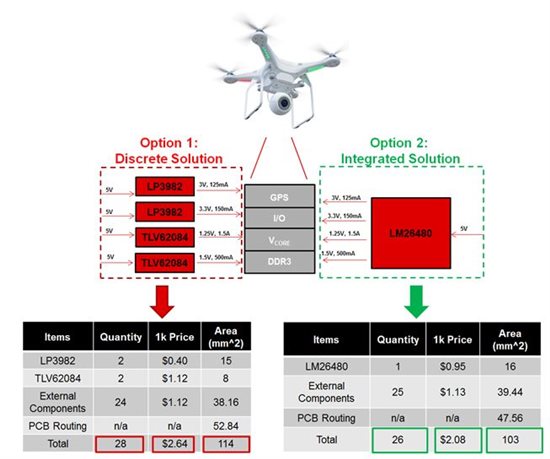SSZTAH6 january 2017 LM26480 , LP3982 , TLV62084
Industrial electronics are trending toward smaller board sizes, sleeker form factors and more cost-effectiveness. Due to these trends, electronic system designers must reduce the size and cost of printed circuit boards (PCBs). Industrial systems using field-programmable gate arrays (FPGAs) and system on chips (SoCs) require multiple power rails while being challenged with small size and low cost. An integrated flexible power device can offer a significant cost savings and solution size reduction for such applications.
An integrated flexible power device contains multiple DC/DC converters within the same package. These DC/DC converters could be any combination of buck converters, boost converters and/or LDOs in a single package. Figure 1 is an example functional block diagram, where the LM26480 includes dual 2MHz high-efficiency 1.5A buck converters and dual 300mA LDOs.
 Figure 1 LM26480 Functional Block
Diagram
Figure 1 LM26480 Functional Block
DiagramLet’s walk through an example that highlights the benefits of using an integrated flexible power device. Imagine designing the power-management system for a drone controlled by an SoC or FPGA. Figure 2 shows four components within this system that are a perfect match for a power-management IC (PMIC).
 Figure 2 Discrete vs. Integrated
Power-management Comparison
Figure 2 Discrete vs. Integrated
Power-management ComparisonBoth power solutions shown will produce four separate rails that power the Global Positioning System (GPS), input/output, core voltage and double data rate type 3 (DDR3) of the system. In both options, a front-end switch-mode power supply efficiently bucks the voltage of the drone battery down to the 5V rail shown as the input to Figure 2. Discrete components can drop this 5V supply further, as shown in option 1, or an integrated device, as shown in option 2.
Imagine powering this system using four separate components: two LP3982 300mA single-channel LDOs and two TLV62084 2A buck converters. You can use these discrete DC/DC converters to power the system, although you will still need four separate active components. This may not be the most optimal solution, considering that active components have the highest reliability issues.
An alternative solution could be to use an integrated flexible power device that provides the desired voltage and current capabilities of the system with just a single IC. As Figure 2 highlights, this provides numerous benefits.
First, the integrated solution is 20% more cost-effective when compared to the discrete solution. Second, the PMIC solution requires 10% less board space compared to the combined board space of the four discrete devices. Third, the integrated device requires fewer external components than the discrete solution, which further decreases overall size and cost. And decreasing the bill of materials (BOM) device count can lead to increased reliability.
So consider an integrated flexible power device when designing systems that require multiple power rails, especially in applications requiring FPGA or SoC power.
Additional Resources
- Check out TI’s PMIC selection for more ways to power your FPGA and SoC.
- Download TI’s PMIC solutions overview.